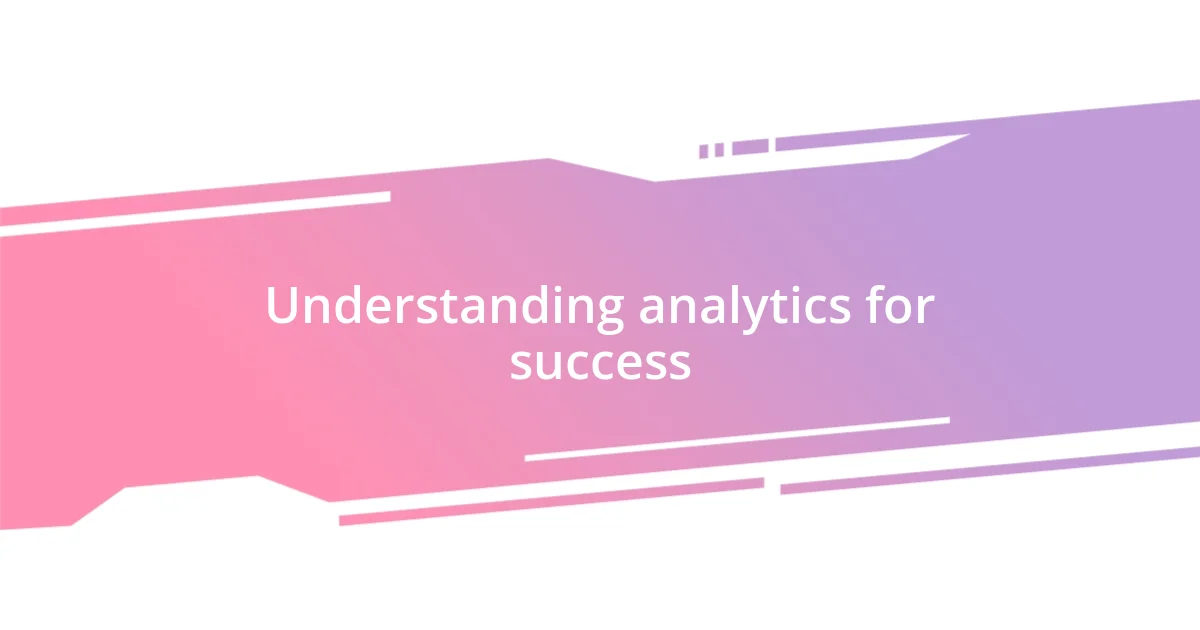Key takeaways:
- Analytics should be seen as a storytelling tool that informs strategies and identifies areas for improvement, ultimately enhancing decision-making.
- Choosing the right analytics tools involves considering factors like user-friendliness, scalability, integration, customer support, and cost-effectiveness.
- Implementing insights into strategy requires careful reflection, collaboration, and ongoing evaluation to ensure alignment with objectives and adaptability to new data.

Understanding analytics for success
Understanding analytics for success goes far beyond number crunching. I remember when I first started using analytics—it felt overwhelming, almost like trying to navigate through a maze without a map. But then I realized that these numbers tell a story, revealing patterns and insights that can guide decision-making. Have you ever thought about how your data reflects your goals?
As I delved deeper into analytics, I began to embrace its power to inform my strategies. I found that by closely examining customer behavior, I could tailor my offerings to better meet their needs. It’s fascinating to think that a simple change in approach, driven by data, could lead to a remarkable increase in customer satisfaction. Isn’t it incredible how a little insight can create such a significant impact?
Moreover, I often reflect on how analytics can help identify areas for improvement. For example, analyzing past campaigns taught me what resonated with my audience and what fell flat. This kind of reflective practice doesn’t just enhance current projects; it builds a foundation for future success. So, what lessons have you gleaned from your own experiences with analytics?

Choosing the right analytics tools
Choosing the right analytics tools can feel a bit like finding the perfect pair of shoes; they need to fit just right to support your journey. I remember the first time I chose a tool for my analytics needs—I was overwhelmed by the options. However, after prioritizing what matters most for my goals, I zeroed in on tools that streamline the data I needed without adding unnecessary complexities.
When choosing analytics tools, consider the following factors:
- User-Friendly Interface: I value tools that make it easy to visualize data without having to sift through endless spreadsheets.
- Scalability: As my projects grew, I needed analytics that could grow with me, accommodating more data and deeper insights.
- Integration Capabilities: I appreciate tools that play nicely with other software I already use; it saves time and avoids headaches.
- Customer Support: It’s crucial to have a responsive support system; there have been times when I needed assistance, and good support made all the difference.
- Cost-Effectiveness: I’m always mindful of my budget—ensuring that the tool provides great value is essential.
These considerations have shaped my approach and made my analytics journey much more rewarding. Balancing functionality with ease of use is key for success in harnessing data effectively.

Setting clear goals for analytics
Setting clear goals for analytics is a crucial first step in ensuring that your efforts yield meaningful insights. When I began my analytics journey, I learned that vague ambitions lead to confusion and inaction. For instance, instead of saying, “I want to improve customer satisfaction,” I set a concrete goal: “I want to increase my customer satisfaction score by 20% over the next six months.” By establishing such specific targets, I could align my analytics efforts toward measurable outcomes and evaluate my progress effectively.
I’ve also experienced the transformative power of setting benchmarks. When I decided to launch a new marketing campaign, I outlined my objectives clearly—such as increasing website traffic by 30% and enhancing conversion rates by 15%. This clarity guided not only my data collection but also shaped my strategic decisions. It felt empowering to know that each data point I collected was a step toward achieving my goals, ultimately leading to tangible results.
Moreover, I discovered that having clear goals creates a sense of accountability. I implemented a regular review process, allowing me to track my progress against those established objectives. There were moments I faced setbacks, but with specific goals, it was easier to identify areas requiring adjustment. Have you ever noticed how defined targets can lead to proactive behavior? It’s those precise goals that keep us focused and motivated over time.
| Goals | Benefits |
|---|---|
| Specific Goals | Provide clarity and measurable outcomes. |
| Benchmarks | Guide strategic decisions and track progress. |
| Accountability | Encourage proactive behavior and adaptation. |

Collecting and organizing data effectively
Collecting data is just the start; organizing it effectively can make all the difference. I remember when my first spreadsheet looked like a chaotic mess, and trying to pull insights from that was like searching for a needle in a haystack. Now, I use a structured approach: categorizing data points by themes or metrics. This not only simplifies analysis but also allows me to quickly spot trends. Have you ever felt like you were drowning in data and couldn’t see a way out?
Once data is collected, organizing it becomes a strategic mission. I found that employing a consistent labeling system has streamlined my workflows immensely. For example, I color-code different types of metrics—like conversion rates in green and customer feedback in blue. This visual aid transforms the data from a daunting collection of numbers into a story waiting to be told. I can instantly grasp which areas are thriving and which need attention. Isn’t it amazing how a bit of organization can breathe life into raw data?
Moreover, I prioritize regular data audits—something I once overlooked. Initially, I would collect data and forget about it until I needed it again, leading to some frustrating moments. But now, I set aside time each month to check for accuracy and relevance. By ensuring my data remains clean and up-to-date, I not only save precious time but also feel a sense of control over my analytics journey. How often do you reflect on the quality of your data? Implementing these practices makes my analysis feel more purposeful and aligned with my goals.

Analyzing data to drive decisions
Analyzing data to drive decisions is where the magic truly happens. After gathering and organizing the data, I dive into the analysis phase, which I find exhilarating. For example, when I analyzed customer behavior patterns for a recent campaign, what stood out were the unexpected demographics engaging with my content. I remember the moment I realized that a segment I hadn’t focused on was actually driving significant traffic. Have you ever discovered insights that completely changed your perspective? It’s like uncovering hidden treasure!
Once armed with insights, I make decisions that feel informed and intentional. For instance, after noticing a trend of younger customers preferring mobile interactions, I shifted my marketing strategy to prioritize mobile-friendly content. That decision led to a marked increase in engagement rates. I’ve found that the more proactive I am in adapting based on data, the better results I achieve. How empowering is it to steer your course based on solid evidence rather than guesswork?
Moreover, I’ve learned to remain flexible in my decision-making process. The beauty of data analysis is that it’s not just a one-time event; it’s an ongoing conversation. I continuously revisit and reassess my decisions as new data comes in. I experienced this firsthand when I initially allocated a large budget to traditional advertising and noticed a drop in response rates. By promptly reallocating resources based on analytics, I redirected funds toward digital campaigns which saw a revival in engagement. Isn’t it fascinating how being open to change can help you stay ahead in an ever-evolving landscape?

Implementing insights into strategy
I’ve found that implementing insights into strategy requires a balance between patience and decisiveness. When I identify a key insight, I don’t jump in headfirst; instead, I take a moment to reflect on how it aligns with my overall objectives. For example, I once noticed a sizable gap in customer engagement during evenings. Rather than immediately launching a campaign, I spent time analyzing whether this was a shift in behavior or just an anomaly. This careful consideration ensured that when I did make changes, they were well thought out and relevant. Have you ever rushed into a decision only to realize it wasn’t the right move?
In my experience, effective implementation often involves collaboration. I remember when I gathered my team to discuss insights from our latest data report. We brainstormed different ways to leverage the information, and it was fascinating to see how varied perspectives led to innovative strategies. This collective input not only fostered a deeper understanding among the team but also made everyone feel invested in the outcomes. Doesn’t it feel rewarding when a collaboration sparks creativity?
Lastly, I constantly evaluate the impact of the changes we implement. After updating our customer engagement strategy, I diligently tracked key performance indicators (KPIs) to measure success. At first, the numbers didn’t reflect the immediate uplift I had hoped for, and I found myself feeling a bit disheartened. However, instead of overlooking the data, I sought feedback from customers about their experiences. This iterative process helped me refine the approach over time, turning a slow start into a rewarding journey. How do you ensure that your strategies align with actual results as they unfold?

Monitoring and refining analytics processes
Monitoring and refining analytics processes is essential to my success. I approach it like a craftsman honing their tools—always seeking ways to improve and adapt. For instance, there was a time when I relied heavily on a set of standard metrics to evaluate performance. It wasn’t until I started digging deeper, incorporating user feedback into my analytics review, that I realized I was missing out on valuable insights. Have you ever felt like you were just scratching the surface of what’s possible?
As I continue to track the effectiveness of my analytics tools, I consistently ask myself: Are these metrics telling me the whole story? I’ve found that combining quantitative data with qualitative insights often leads to richer understanding. Recently, I revisited my customer satisfaction scores and cross-referenced them with detailed comments from surveys. This dual perspective allowed me to refine my strategy in a way that purely numerical data never could. It made me question the assumptions I held—how often do we rely solely on numbers, ignoring the context behind them?
Furthermore, I’ve learned the value of periodic reviews in analytics processes. Early on, I was so focused on my daily data checks that I overlooked the broader trends. This changed after I established a regular schedule for comprehensive method evaluations. I vividly remember a quarterly session when I discovered that a minor tweak in our product’s user interface was driving a more significant change in user retention than I had anticipated. This proactive monitoring shifted my focus from simply reacting to data toward anticipating customer needs. How do you keep track of changes that could impact your strategy in the long term?














